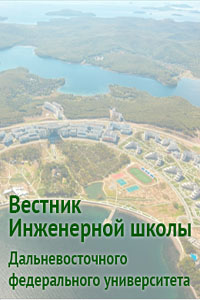Evaluation of wooden elements operabilit spans of short length road bridges
DOI:
https://doi.org/10.24866/2227-6858/2024-1/113-121Keywords:
bridge, span, log beam, crossbeams, wood, strength class, time loadAbstract
Wood has long been used as a building material, including during the construction of transport structures. Accessibility, ease of processing, and in certain historical periods and lack of alternatives led to the mass construction of wooden bridge structures. Due to the peculiarities of such natural material, against the background of the development of the construction industry and the increasing requirements for transport infrastructure, wood is being displaced from transport construction as a material, but at present there are a fairly noticeable number of road bridges with wooden load-bearing elements designed and built in previous periods. In addition, the current norms allow the use of wood in bridge construction, which in some cases is advisable and finds its implementation. Thus, in the process of maintaining existing and newly built bridges with wooden structural elements, the issue of assessing their consumer properties, in particular lifting capacity, is relevant, which is necessary in the purpose of operating modes, making decisions on inter-repair periods and the purpose of the level of repair impact. The purpose of this study is to assess the operability of the wooden load-carrying elements of the span structures of the bridges in operation based on the actual data on the state of wood, obtained visually during the inspection of objects.
References
Лицингер Ю.К., Клевеко В.И. Использование деревянных мостов малых пролетов в городских условия // Модернизация и научные исследования в транспортном комплексе. 2022. Т. 1. С. 349–351. EDN: PDOHMV
Свирин К.А. Зарубежные пешеходные мосты из деревянных клееных конструкций // Молодой ученый. 2020. № 19(309). С. 66–72. EDN: XVDUIL
Wimmers G. Wood: a construction material for tall buildings // Nature Reviews Materials. 2017. № 2(12). Art. 17051. https://doi.org/10.1038/natrevmats.2017.51
Уткин В.А., Матвеев С.А. Особенности проектирования деревянных мостов автомобильных лесовозных дорог // Известия высших учебных заведений. Лесной журнал. 2023. № 1(391). С. 126–152. https://doi.org/10.37482/0536-1036-2023-1-126-152
Slósarz S. Strengthening of the wooden structures // Budownictwo i Architektura. 2020. Vol. 18, № 3. P. 017–028. https://doi.org/10.35784/bud-arch.561
Soloviev V.A., Chubinsky M.A., Chubinsky A.N., Varankina G.S., Artemenkov A.M. The decay resistance and durability of wood and wood products from larch (LARIX SIBIRICA) // Mycology and Phytopathology. 2019. Vol. 53, № 3. P. 156–161. https://doi.org/10.1134/S0026364819030061
Погорельцев А.А., Пятикрестовский К.П. Дальнейшее развитие и совершенствование норм проектирования конструкций из древесины // Промышленное и гражданское строительство. 2019. № 3. С. 35–41. https://doi.org/10.33622/0869-7019.2019.03.35-41
Валиев Ш.Н., Васильев А.И. Оценка параметрической надежности мостовых сооружений // Транспортное строительство. 2022. № 2. С. 4–6. EDN: TLWEZH
Шестовицкий Д.А. Обоснование надёжности и сроков службы проектируемых мостов // Дороги и мосты. 2021. № 2(46). С. 203–227. EDN: IAJNYA
Петрова Т.М., Беленцов Ю.А., Лейкин А.П., Тихонов Ю.М. Особенности проектирования и контроля качества деревянных конструкций с учетом класса древесины по прочности // Вестник гражданских инженеров. 2020. № 6(83). С. 156–159. https://doi.org/10.23968/1999-5571-2020-17-6-156-159
Downloads
Published
Issue
Section
License
Copyright (c) 2024 Far Eastern Federal University: School of Engineering Bulletin

This work is licensed under a Creative Commons Attribution 4.0 International License.

